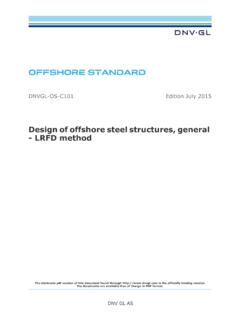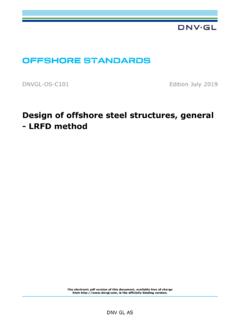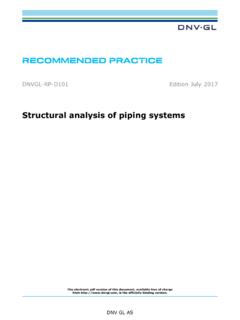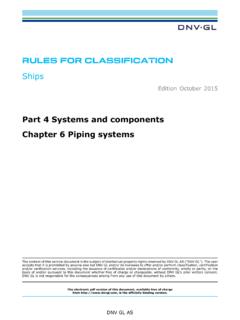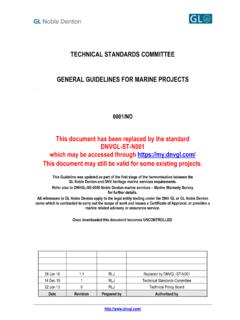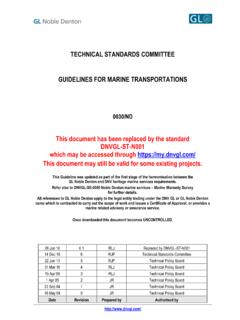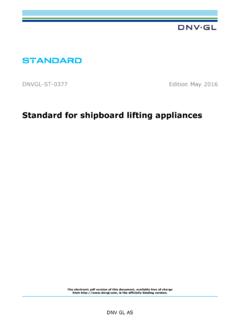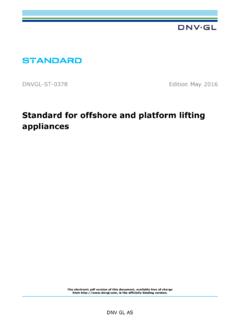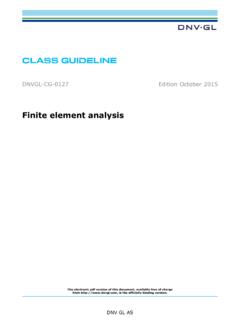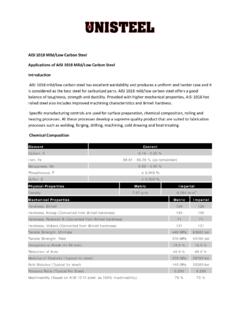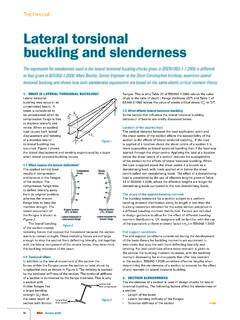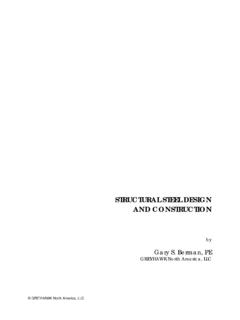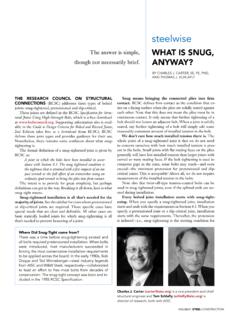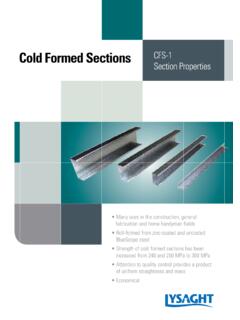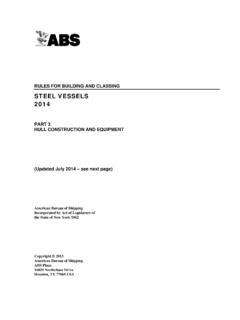Transcription of DNVGL-RU-SHIP-Pt6Ch6 Cold climate
1 The content of this service document is the subject of intellectual property rights reserved by DNV GL AS ("DNV GL"). The useraccepts that it is prohibited by anyone else but DNV GL and/or its licensees to offer and/or perform classification, certificationand/or verification services, including the issuance of certificates and/or declarations of conformity, wholly or partly, on thebasis of and/or pursuant to this document whether free of charge or chargeable, without DNV GL's prior written GL is not responsible for the consequences arising from any use of this document by electronic pdf version of this document, available free of chargefrom , is the officially binding GL ASRULES FOR CLASSIFICATIONS hipsEdition October 2015 Part 6 Additional class notationsChapter 6 Cold climateFOREWORDDNV GL rules for classification contain procedural and technical requirements related to obtainingand retaining a class certificate.
2 The rules represent all requirements adopted by the Society asbasis for classification. DNV GL AS October 2015 Any comments may be sent by e-mail to any person suffers loss or damage which is proved to have been caused by any negligent act or omission of DNV GL, then DNV GL shallpay compensation to such person for his proved direct loss or damage. However, the compensation shall not exceed an amount equal to tentimes the fee charged for the service in question, provided that the maximum compensation shall never exceed USD 2 this provision "DNV GL" shall mean DNV GL AS, its direct and indirect owners as well as all its affiliates, subsidiaries, directors, officers,employees, agents and any other acting on behalf of DNV 6 Chapter 6 Changes - currentRules for classification: Ships DNVGL-RU-SHIP-Pt6Ch6 . Edition October 2015 Page 3 Cold climate DNV GL ASCHANGES CURRENTThis is a new rules enter into force 1 January 6 Chapter 6 ContentsRules for classification: Ships DNVGL-RU-SHIP-Pt6Ch6 .
3 Edition October 2015 Page 4 Cold climate DNV GL ASCONTENTSC hanges 1 Basic ice strengthening - Class Documentation 113 Marking and onboard Loading Structural requirements for the class notation Ice(C).. Stringers and web Weld Rudder and steering 147 Machinery requirements for class notation Ice(C).. Output of propulsion Design of propeller and propeller Sea suctions and Structural requirements for class notation Ice(E).. 199 Machinery requirements for class notation Ice(E).. 19 Part 6 Chapter 6 ContentsRules for classification: Ships DNVGL-RU-SHIP-Pt6Ch6 . Edition October 2015 Page 5 Cold climate DNV GL Propeller shafts, intermediate shafts, thrust Shrunk Sea chests and discharge Steering Electric propeller 2 Ice strengthening for the Northern Baltic - 241 Class Documentation 263 Marking and onboard Loading Design Height of the ice load Ice 298 Shell Vertical extension of ice strengthening for Plate thickness in the ice Vertical extension of ice Transverse Longitudinal Structural Ice Stringers within the ice Stringers outside the ice Deck 3811 Web 38 Part 6 Chapter 6 ContentsRules for classification: Ships DNVGL-RU-SHIP-Pt6Ch6 .
4 Edition October 2015 Page 6 Cold climate DNV GL Design ice Section modulus and shear 3812 Bilge Special arrangement and strengthening Stem, Baltic ice Arrangements for Special arrangement and strengthening Rudder and steering 4115 Propulsion Engine Design loads for propeller and Design Design loads on propeller Axial design loads for open and ducted Torsional design Blade failure Design Propeller blade Propeller bossing and CP Propulsion shaft Design of shaft line components not specifically mentioned in Azimuth main propulsors and other Alternative Miscellaneous machinery Starting Sea inlet and cooling water Ballast Guidelines for strength analysis of the propeller blade using finiteelement 3 Operations in cold climate - Class 71 Part 6 Chapter 6 ContentsRules for classification: Ships DNVGL-RU-SHIP-Pt6Ch6 .
5 Edition October 2015 Page 7 Cold climate DNV GL Documentation 743 Certification Design environmental General Anti-icing and anti-freezing De-icing Requirements to Requirements to 4 Design ambient temperature - 1111 Class Documentation 1122 Material Structural Selection of steel 116 Section 5 Polar class - 1181 Class Documentation 1193 Design Design temperature for structure and Hull System 1214 Design ice loads 122 Part 6 Chapter 6 ContentsRules for classification: Ships DNVGL-RU-SHIP-Pt6Ch6 . Edition October 2015 Page 8 Cold climate DNV GL Glancing impact load Bow Hull areas other than the Design load Pressure within the design load Hull area Ice compression load 1295 Local strength Shell plate Framing Framing transversely framed side structures and bottom Framing side longitudinals (longitudinally framed ships).
6 Framing web frame and load carrying Framing structural Plated Stem and stern End connections for framing Longitudinal Design vertical ice force at the Design vertical shear Design vertical ice bending Longitudinal strength Ice forces on Rudder Ice loads on propeller Propeller nozzle Podded propulsors and azimuth 1498 Direct 1499 Minimum weld 15010 Materials and corrosion Corrosion/abrasion additions and steel Hull 6 Chapter 6 ContentsRules for classification: Ships DNVGL-RU-SHIP-Pt6Ch6 . Edition October 2015 Page 9 Cold climate DNV GL Materials for machinery components exposed to sea Materials for machinery components exposed to sea water temperatures. Materials for machinery components exposed to low air Ice interaction loads Propeller ice Ice class Design ice loads for open Design ice loads for ducted Propeller blade loads and stresses for fatigue Design ice loads for propulsion Machinery fastening loading 16612 Design Design Propeller blade Fatigue design of propeller Blade flange, bolts and propeller hub and CP Propulsion line Azimuth main Steering Prime Auxiliary Sea inlets.
7 Cooling water systems and ballast Ballast Ventilation Alternative 18213 Stability and watertight Intact Requirements to watertight 182 Appendix A Guidelines for strength analysis of the propeller blade using finiteelement Guidelines for strength analysis of the propeller blade using finiteelement Requirements for FE Good engineering practice for FE Boundary Applied pressure 184 Part 6 Chapter 6 Section 1 Rules for classification: Ships DNVGL-RU-SHIP-Pt6Ch6 . Edition October 2015 Page 10 Cold climate DNV GL ASSECTION 1 BASIC ICE STRENGTHENING - ICE1 IntroductionThe additional class notation Ice establishes requirements for ships intended for service in waters with lightice conditions and light localised drift ice, in river mouths and coastal ScopeThe scope for additional class notation Ice specifies requirements for hull strength, machinery systems andequipment, and includes the relevant procedural requirements applicable to ships operating in light ice andlight localised drift ice conditions in river mouths and coastal ApplicationThe additional class notation Ice applies to ships built in compliance with the requirements as specified inTable 1 and may be assigned a qualifier related to structural strength and machinery.
8 Ships navigating inwaters with light ice conditions may be assigned the class notation Ice(C), and ships navigating in waterswith light localised drift ice conditions may be assigned the class notation Ice(E). The requirements for classnotation Ice(E) are intended for light localised drift ice in mouths of river and coastal Class notationsShips built in compliance with the requirements as specified in Table 1 will be assigned the additional notationrelated to structural strength and integrity as follows:Table 1 Additional class notation related to cold climateClass NotationQualifierPurposeApplicationCShip s intended for navigationin light ice conditionsIce Mandatory:No Design requirements:[6] to [9] FiS , and intended for navigationin light localised drift icePart 6 Chapter 6 Section 1 Rules for classification: Ships DNVGL-RU-SHIP-Pt6Ch6 .
9 Edition October 2015 Page 11 Cold climate DNV GL DefinitionsTable 2 DefinitionsTermsDefinitionthe upper ice water line(UIWL)is the envelope of the highest points of the waterline at which the ship is intended to operatein ice irrespective of water salinity. The line may be a broken lower ice water line(LIWL)is the envelope of the lowest points of the waterline at which the ship is intended to operatein ice. The line may be a broken SymbolsFor symbols not defined in this section, refer to spacing measured along the plating between ordinary and/or intermediate stiffeners, in Documentation requirementsDetails related to design, arrangement and strength are in general to be included in the plans specified forthe main Marking and onboard The maximum and minimum ice class draughts fore, amidships and aft shall be indicated in the appendix to the classification certificate.
10 If the Summer Load Line in fresh water is anywhere located at a higher level than the UIWL, theship sides shall be provided with a warning triangle and with ice class draught marks at the maximumpermissible amidships draught, see Figure 1, and the maximum permissible draught amidships shall beexplicitly indicated in the appendix to the classification certificate . Part 6 Chapter 6 Section 1 Rules for classification: Ships DNVGL-RU-SHIP-Pt6Ch6 . Edition October 2015 Page 12 Cold climate DNV GL ASICEICE Figure 1 Ice class draught Marking requirements1) The ice class draught marking ICE shall indicate the maximum ice class ) The upper edge of the warning triangle shall be located vertically above the ICE mark, at the height1000 mm above Summer Fresh Water Load Line, but not higher than the deck line. The sides of thetriangle shall be 300 mm in ) The ice class draught mark shall be located 540 mm abaft the centre of the load line ring or 540 mmabaft the vertical line of the timber load line mark, if ) The ice marks and letters shall be cut out of 5 to 8 mm plate and then welded to the ship's side ormarking shall be indicated by weld seam directly on the ship side.
